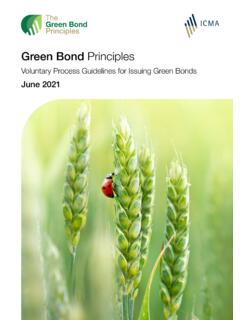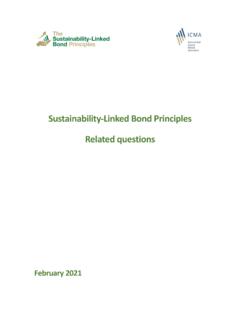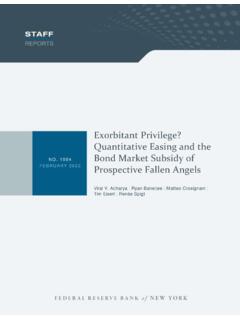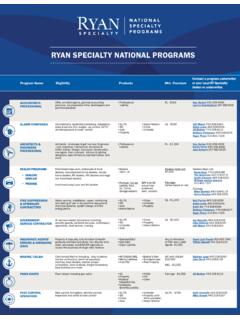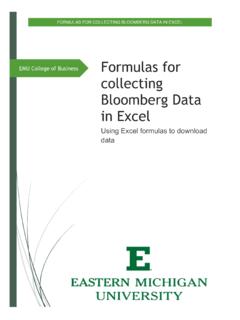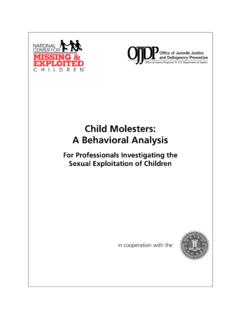Transcription of Social Bond Principles
1 Social bond PrinciplesVoluntary Process Guidelines for Issuing Social BondsJune 2021 PrinciplesJune 2021 Social bond PrinciplesVoluntary Process Guidelines for Issuing Social BondsIntroductionThe Social bond Principles (SBP), together with the Green bond Principles (GBP), the Sustainability bond Guidelines (SBG) and the Sustainability-Linked bond Principles (SLBP) are published under the governance of the Principles . The Principles are a collection of voluntary frameworks with the stated mission and vision of promoting the role that global debt capital markets can play in financing progress towards environmental and Social sustainability. The Principles outline best practices when issuing bonds serving Social and/or environmental purposes through global guidelines and recommendations that promote transparency and disclosure, thereby underpinning the integrity of the market. The Principles also raise awareness of the importance of environmental and Social impact among financial market participants, which ultimately aims to attract more capital to support sustainable SBP seek to support issuers in financing socially sound and sustainable projects that achieve greater Social benefits.
2 SBP-aligned issuance should provide transparent Social credentials alongside an investment opportunity. By recommending that issuers report on the use of Social bond proceeds, the SBP promote a step change in transparency that facilitates the tracking of funds to Social projects, while simultaneously aiming to improve insight into their estimated SBP provide high level categories for eligible Social Projects in recognition of the diversity of current views and of the ongoing development in understanding of Social issues and consequences. The SBP encourage all participants in the market to use this foundation to develop their own robust practices, referencing a broad set of complementary criteria as SBP are collaborative and consultative in nature based on the contributions of Members and Observers of the Principles , and of the wider community of stakeholders. They are updated as required in order to reflect the development and growth of the global Social bond market.
3 The SBP, and the Principles generally, are coordinated by the Executive Committee with the support of the addition to the SBP, the Principles offer approaches that reflect issuer level sustainability commitments, which can supplement or provide an alternative to a focus on use of proceeds. Such commitments can be expressed through Sustainability-Linked Bonds, as well as through dedicated issuer strategies and disclosures as recommended by the Climate Transition Finance Handbook when communicating Paris-aligned transition plans. An illustration of the products and related guidance covered by the Principles is depicted in Appendix 2021 Edition of the SBPThe 2021 edition of the SBP, consistent with the 2021 edition of the GBP, benefits from the feedback of the 2020 consultation of the Members and Observers of the Principles , the Advisory Council, as well as from the input of the working groups coordinated by the Executive Committee with the support of the , the 2021 edition of the SBP identifies key recommendations regarding Social bond Frameworks and External Reviews alongside the four core components of the SBP.
4 It recommends heightened transparency for issuer-level sustainability strategies and commitments. Further, it provides guidance on issuer processes to identify mitigants to known material risks of negative Social and/or environmental impacts. It also contains additional clarifications and updates relating to recommended market practice. This edition otherwise includes important references to complementary guidance from the Principles included in the Harmonised Framework for Impact Reporting for Social Bonds and the Guidelines for External Reviews, which are supplemented by the Guidance Handbook. Social bond DefinitionSocial Bonds are any type of bond instrument where the proceeds, or an equivalent amount, will be exclusively applied to finance or re-finance in part or in full new and/or existing eligible Social Projects (see Use of Proceeds section) and which are aligned with the four core components of the SBP. Different types of Social Bonds exist in the market.
5 These are described in Appendix is understood that certain eligible Social Projects may also have environmental co-benefits, and that the classification of a use of proceeds bond as a Social bond should be determined by the issuer based on its primary objectives for the underlying projects. (bonds that intentionally mix Green and Social Projects are referred to as Sustainability Bonds, and specific guidance for these is provided separately in the Sustainability bond Guidelines).It is important to note that Social Bonds should not be considered fungible with bonds that are not aligned with the four core components of the SBP. Bonds issued under earlier Social bond Guidance released prior to this version are deemed consistent with the bond PrinciplesThe SBP are voluntary process guidelines that recommend transparency and disclosure and promote integrity in the development of the Social bond market by clarifying the approach for issuance of a Social bond .
6 The SBP are intended for broad use by the market: they provide issuers with guidance on the key components involved in launching a credible Social bond ; they aid investors by promoting availability of information necessary to evaluate the positive impact of their Social bond investments; and they assist underwriters offering vital steps that will facilitate transactions and preserve integrity of the market. The SBP recommend a clear process and disclosure for issuers, which investors, banks, underwriters, arrangers, placement agents and others may use to understand the characteristics of any given Social bond . The SBP emphasize the required transparency, accuracy and integrity of the information that will be disclosed and reported by issuers to stakeholders through core components and key four core components for alignment with the Social bond Principles are:1. Use of Proceeds 2. Process for Project Evaluation and Selection 3. Management of Proceeds 4.
7 ReportingThe key recommendations for heightened transparency are:(i) Social bond Frameworks (ii) External Reviews1. Use of ProceedsThe cornerstone of a Social bond is the utilisation of the proceeds of the bond for eligible Social Projects which should be appropriately described in the legal documentation of the security. All designated eligible Social Projects should provide clear Social benefits, which will be assessed and, where feasible, quantified by the the event that all or a proportion of the proceeds are or may be used for refinancing, it is recommended that issuers provide an estimate of the share of financing vs. re-financing, and where appropriate, also clarify which investments or project portfolios may be refinanced, and, to the extent relevant, the expected look-back period for refinanced eligible Social Projects directly aim to address or mitigate a specific Social issue and/or seek to achieve positive Social outcomes Voluntary Process Guidelines for Issuing Social Bonds3especially but not exclusively for a target population(s).
8 A Social issue threatens, hinders, or damages the well-being of society or a specific target population. For the avoidance of doubt, it is acknowledged that the definition of target population can vary depending on local contexts and that, in some cases, such target population(s) may also be served by addressing the general public. Please see below illustrative examples of Social Project categories. The following list of project categories, while indicative, captures the most commonly used types of projects supported, or expected to be supported, by the Social bond market. Social Projects include assets, investment and other related and supporting expenditures, such as research and development that may relate to more than one Project categories include, but are not limited to, providing and/or promoting: Affordable basic infrastructure ( clean drinking water, sewers, sanitation, transport, energy) Access to essential services ( health, education and vocational training, healthcare, financing and financial services) Affordable housing Employment generation, and programs designed to prevent and/or alleviate unemployment stemming from socioeconomic crises, including through the potential effect of SME financing and microfinance Food security and sustainable food systems ( physical, Social , and economic access to safe, nutritious, and sufficient food that meets dietary needs and requirements; resilient agricultural practices; reduction of food loss and waste.)
9 And improved productivity of small-scale producers) Socioeconomic advancement and empowerment ( equitable access to and control over assets, services, resources, and opportunities; equitable participation and integration into the market and society, including reduction of income inequality)Examples of target populations include, but are not limited to, those that are: 1. Living below the poverty line 2. Excluded and/or marginalised populations and/or communities 3. People with disabilities 4. Migrants and/or displaced persons 5. Undereducated 6. Underserved, owing to a lack of quality access to essential goods and services 7. Unemployed 8. Women and/or sexual and gender minorities9. Aging populations and vulnerable youth10. Other vulnerable groups, including as a result of natural disasters There are several categories and sets of criteria defining Social Projects already in existence in the market that can be used as complementary guidance.
10 Issuers and other stakeholders can refer to case studies and examples through links that can be found in the sustainable finance section of ICMA s website. Definitions of Social Projects may also vary depending on sector and Process for Project Evaluation and SelectionThe issuer of a Social bond should clearly communicate to investors: The Social objectives of the Social Projects; The process by which the issuer determines how the projects fit within the eligible Social Project categories (examples are identified above); and Complementary information on processes by which the issuer identifies and manages perceived Social and environmental risks associated with the relevant Project(s). Issuers are also encouraged to Position the information communicated above within the context of the issuer s overarching objectives, strategy, policy and/or processes relating to Social sustainability. Provide information on the related eligibility criteria, including if applicable, exclusion criteria and also disclose any Social standards or certifications referenced in project selection.


